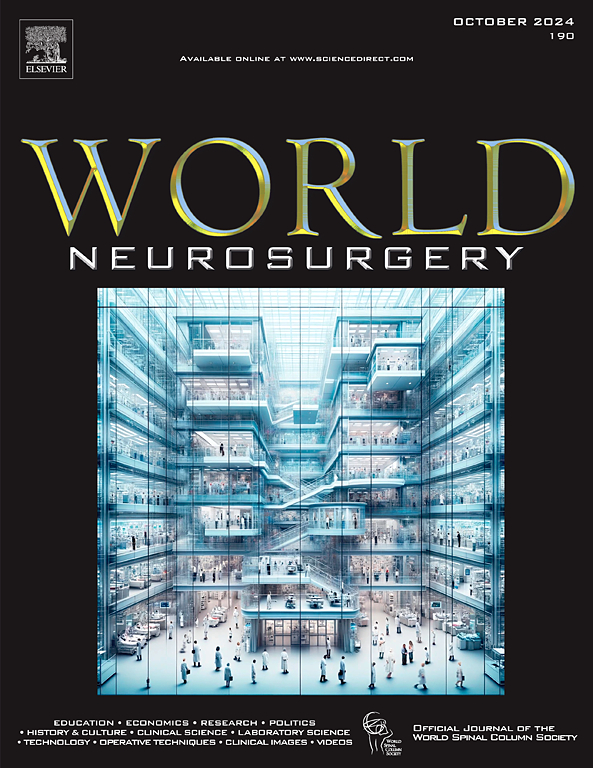A Simple Technique of Cerebrospinal Fluid Leak Prevention Following Endoscopic Third Ventriculostomy: A Technical Note
IF 1.9
4区 医学
Q3 CLINICAL NEUROLOGY
引用次数: 0
Abstract
Background
There are a variety of complications of endoscopic third ventriculostomy (ETV) that have been described in the literature. Cerebrospinal fluid leak is one of the common complications that need to be addressed properly and timely management plays a crucial role in prevention of meningitis/encephalitis.
Objective
To share our experience of using autologous bone (from burr hole) debris and “BloodSTOP” absorbable hemostatic agent as an effective tool in cerebrospinal fluid leak prevention.
Methods
We have observed 14 individuals who have undergone an ETV procedure using the abovementioned multilayered technique of burr hole closure at our institution in 2024.
Results
A watertight dural closure is a mandatory step in every case of neurosurgical procedure. But when primary dural closure is not possible in endoscopic intraventricular surgeries, there is a way out using more affordable hemostatic materials like BloodSTOP. There are plenty of strategies in surgical closure technique, including pericranial graft, dural allografts and synthetic substitutes, and various sealants but no single consensus on the best practice regarding dural closure. TachoSil is a hemostatic agent consisting of human fibrinogen and thrombin coated onto an equine collagen sponge and has proven efficacy as a sealant for easy repair of encephalocele, incidental spinal durotomy, transsphenoidal surgery, and intradural cranial and spinal lesions.
Conclusions
We report the use of a simple novel, sutureless BloodSTOP sandwich dural closure technique for post ETV dural defects, which has proven efficacy in our study when watertight primary dural closure is not technically feasible.
内镜下第三脑室造口术后防止脑脊液泄漏的简单技术:技术说明。
背景:文献报道了内镜下第三脑室造口术(ETV)的各种并发症。脑脊液漏是常见的并发症之一,需要妥善处理,及时管理对预防脑膜炎/脑炎起着至关重要的作用。目的:分享使用自体骨(钻孔)碎片和“止血”可吸收止血剂作为预防脑脊液泄漏的有效工具的经验。材料和方法:我们于2024年在我院观察了14例采用上述多层封孔技术进行ETV手术的患者。讨论:在所有神经外科手术中,硬脑膜水密闭合是必须的步骤。但是,当内窥镜脑室手术无法进行初级硬脑膜闭合时,有一种方法可以使用更便宜的止血材料,如BloodSTOP。手术闭合技术有很多策略,包括颅周移植、硬脑膜异体移植和合成替代物,以及各种密封剂,但对于硬脑膜闭合的最佳实践没有统一的共识。TachoSil是一种止血剂,由人纤维蛋白原和凝血酶组成,涂覆在马胶原蛋白海绵上,已被证明是一种易于修复脑膨出、偶然的脊髓硬膜切开术、经蝶窦手术、硬膜内颅脑和脊髓病变的密封剂。结论:我们报告了一种简单新颖的、无缝合线的BloodSTOP夹心硬脑膜封闭技术用于ETV后硬脑膜缺损,在我们的研究中,当初级硬脑膜水密封闭技术不可行时,该技术已被证明是有效的。
本文章由计算机程序翻译,如有差异,请以英文原文为准。
求助全文
约1分钟内获得全文
求助全文
来源期刊

World neurosurgery
CLINICAL NEUROLOGY-SURGERY
CiteScore
3.90
自引率
15.00%
发文量
1765
审稿时长
47 days
期刊介绍:
World Neurosurgery has an open access mirror journal World Neurosurgery: X, sharing the same aims and scope, editorial team, submission system and rigorous peer review.
The journal''s mission is to:
-To provide a first-class international forum and a 2-way conduit for dialogue that is relevant to neurosurgeons and providers who care for neurosurgery patients. The categories of the exchanged information include clinical and basic science, as well as global information that provide social, political, educational, economic, cultural or societal insights and knowledge that are of significance and relevance to worldwide neurosurgery patient care.
-To act as a primary intellectual catalyst for the stimulation of creativity, the creation of new knowledge, and the enhancement of quality neurosurgical care worldwide.
-To provide a forum for communication that enriches the lives of all neurosurgeons and their colleagues; and, in so doing, enriches the lives of their patients.
Topics to be addressed in World Neurosurgery include: EDUCATION, ECONOMICS, RESEARCH, POLITICS, HISTORY, CULTURE, CLINICAL SCIENCE, LABORATORY SCIENCE, TECHNOLOGY, OPERATIVE TECHNIQUES, CLINICAL IMAGES, VIDEOS
 求助内容:
求助内容: 应助结果提醒方式:
应助结果提醒方式:


